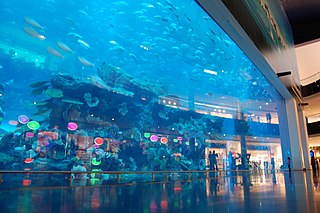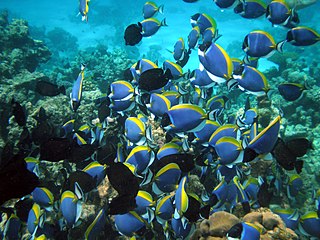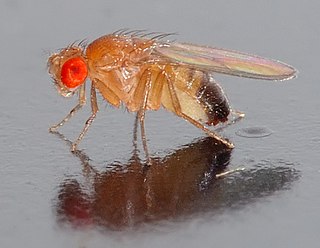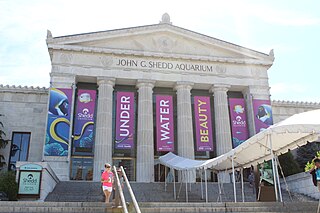
Shedd Aquarium is an indoor public aquarium in Chicago, Illinois in the United States that opened on May 30, 1930. The aquarium contains 32,000 animals, and was for some time the largest indoor aquarium in the world with 5,000,000 US gallons of water. Shedd Aquarium was the first inland aquarium with a permanent saltwater fish collection. Located on Lake Michigan, it is located on the Museum Campus Chicago, which it shares with the Adler Planetarium and the Field Museum of Natural History. In 2015, the aquarium had 2.02 million visitors. It was the most visited aquarium in the U.S. in 2005, and in 2007, it surpassed the Field Museum as the most popular cultural attraction in Chicago. The aquarium contains 1,500 species, including fish, marine mammals, birds, snakes, amphibians, and insects. The aquarium received awards for "best exhibit" from the Association of Zoos and Aquariums (AZA) for Seahorse Symphony in 1999, Amazon Rising in 2001, and Wild Reef in 2004. It was designated a National Historic Landmark in 1987.

The New England Aquarium is a public aquarium located in Boston, Massachusetts. In addition to the main aquarium building, attractions at the New England Aquarium include the Simons IMAX Theatre and the New England Aquarium Whale Watch, which operates from April through November. The aquarium has more than 22,000 members and hosts more than 1.3 million visitors each year.
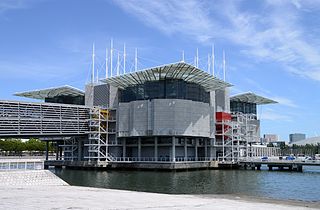
The Lisbon Oceanarium is an oceanarium in Lisbon, Portugal. It is located in the Parque das Nações, which was the exhibition grounds for the Expo '98. It is the largest indoor aquarium in Europe.

Sea Life Sunshine Coast at Mooloolaba, Sunshine Coast, Queensland, Australia is a marine mammal park, oceanarium and wildlife sanctuary. Sea Life Sunshine Coast is an institutional member of the Zoo and Aquarium Association (ZAA). The attraction is a Sea Life Centre owned by Merlin Entertainments, and is globally referred to as Sea Life Sunshine Coast by the firm. It was formerly known as UnderWater World.

Underwater World, also known as Underwater World Singapore Pte Ltd, was a former oceanarium located on the offshore Singaporean island of Sentosa.

Kelly Tarlton's Sea Life Aquarium is a public aquarium in Auckland, New Zealand that was opened in 1985. Located at 23 Tamaki Drive, it was the brainchild of New Zealand marine archaeologist and diver Kelly Tarlton (1937–1985).

An oceanarium can be either a marine mammal park, such as MarineLand, or a large-scale aquarium, such as the Lisbon Oceanarium, presenting an ocean habitat with marine animals, especially large ocean dwellers such as sharks.
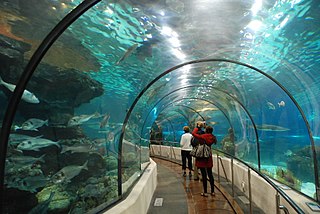
Aquarium Barcelona is an aquarium located in Port Vell, a harbor in Barcelona, Catalonia, Spain.

SEA LIFE Sydney Aquarium contains a large variety of Australian aquatic life, displaying more than 700 species comprising more than 13,000 individual fish and other sea and water creatures from most of Australia's water habitats. Additionally, the aquarium features 14 themed zones including Jurassic Seas, Discovery Rockpool, Shark Walk, and the world’s largest Great Barrier Reef display. Along the way, visitors encounter animals unique to each habitat, including one of only four dugongs on display in the world, sharks, stingrays, penguins and tropical fish, among others.

National Aquarium Denmark, Den Blå Planet is a public aquarium in Denmark. The original aquarium was located in Charlottenlund, but this facility closed in 2012 and most of the animal collection was relocated to the new and much larger aquarium Den Blå Planet in Kastrup, a suburb of Copenhagen. The National Aquarium Denmark, Den Blå Planet opened to the public in March 2013 and is the largest aquarium in Northern Europe.

L'Oceanogràfic is an oceanarium situated in the east of the city of Valencia, Spain, where different marine habitats are represented. It was designed by the architect Félix Candela and the structural engineers Alberto Domingo and Carlos Lázaro. It is integrated inside the cultural complex known as the Ciutat de les Arts i de les Ciències. It was opened on 14 February 2003.
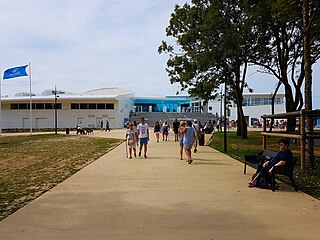
Nausicaā Centre National de la Mer is a public aquarium located in Boulogne-sur-Mer in France. It is the largest public aquarium of Europe.
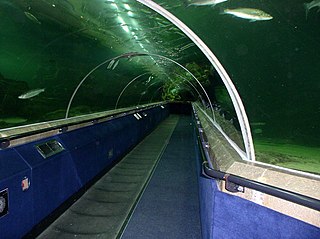
Deep Sea World is an aquarium located in the village of North Queensferry, in Fife, Scotland. It is host to a collection of large sand tiger sharks, also known as ragged toothed sharks or grey nurse sharks, and various other species of shark.

An aquarium is a vivarium of any size having at least one transparent side in which aquatic plants or animals are kept and displayed. Fishkeepers use aquaria to keep fish, invertebrates, amphibians, aquatic reptiles such as turtles, and aquatic plants. The term "aquarium", coined by English naturalist Philip Henry Gosse, combines the Latin root aqua, meaning water, with the suffix -arium, meaning "a place for relating to". The aquarium principle was fully developed in 1850 by the chemist Robert Warington, who explained that plants added to water in a container would give off enough oxygen to support animals, so long as the numbers of animals did not grow too large. The aquarium craze was launched in early Victorian England by Gosse, who created and stocked the first public aquarium at the London Zoo in 1853, and published the first manual, The Aquarium: An Unveiling of the Wonders of the Deep Sea in 1854. An aquarium is a water-filled tank in which fish swim about. Small aquariums are kept in the home by hobbyists. There are larger public aquariums in many cities. This kind of aquarium is a building with fish and other aquatic animals in large tanks. A large aquarium may have otters, turtles, dolphins, and other sea animals. Most aquarium tanks also have plants.

The Great Aquarium – Saint-Malo is an aquarium in Saint-Malo, France. It opened in 1996 and now belongs to the group Compagnie des Alpes, which also owns many other parks in France and Europe. The aquarium houses 11,000 marine animals representing 600 species. It covers 4,000 square metres (43,000 sq ft) and holds 2,500,000 litres (660,000 US gal) of water . 360,000 people visit this site each year making it the second most visited tourist site in Brittany.
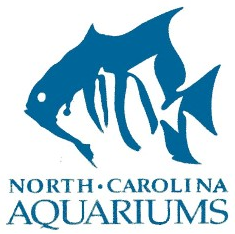
North Carolina Aquariums is a system of three public aquariums located in Kure Beach, Roanoke Island and Pine Knoll Shores. All are operated by the Aquariums Division of the North Carolina Department of Natural and Cultural Resources since 1976 and are accredited by the Association of Zoos and Aquariums. All three aquariums feature dive shows, live animal encounters, and feeding programs.

Chimelong Ocean Kingdom is a theme park situated in Hengqin, Zhuhai, People's Republic of China. It is designed by PGAV Destinations. The park broke ground on 28 November 2010 and soft-opened on 28 January 2014. The grand opening occurred on 29 March 2014. The first phase of the park cost RMB 10 billion to build. It is part of the Chimelong International Ocean Tourist Resort, which aims to become the "Orlando of China". According to TEA and AECOM, it is the 11th most visited theme park in the world in 2017, with over 9.7 million visitors.

Eilat's Coral World Underwater Observatory is a public aquarium, park and conservation center located in Eilat, Israel. It is the biggest public aquarium in Israel, and it hosts over 800 species. It was founded in 1974 and was the first of its kind. The park and aquarium is located to the south of Eilat's Coral Beach nature reserve.
Kattegatcentret is a public aquarium in Grenå, Denmark. Its name refers to the Kattegat sea.

